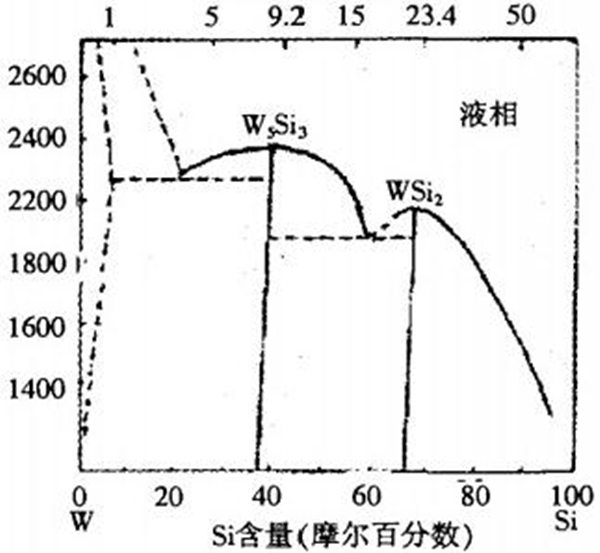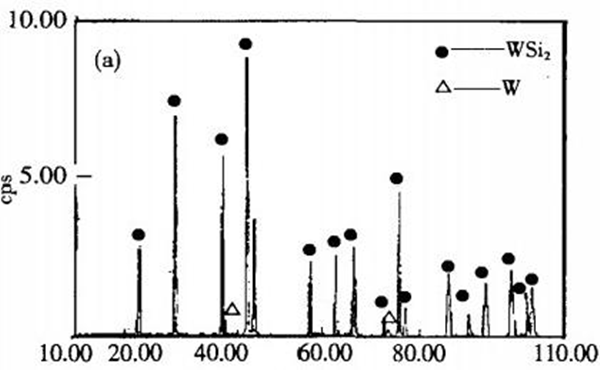Abstract: WSi ₂ powder was successfully prepared using self propagating high-temperature synthesis method. The adiabatic temperature during the synthesis of each phase was calculated, and the order and transformation relationship of each phase were discussed. The phase composition and microstructure of the synthesized product were analyzed using XRD and SEM.
Keywords: powder metallurgy; WSi₂ ; Self propagating high-temperature synthesis
Chinese Library Classification Number: TF123.3 * 3 Literature Identification Code: A
0 Preface
In recent years, with the development of integrated circuit manufacturing technology, the size of circuit features has decreased to less than 2 μ m. The gate electrodes and interconnections also sharply narrow, the contact area decreases, and the contact resistance increases. If polycrystalline silicon is still used as the material for gate electrodes and interconnects, it will seriously affect the power consumption and operating speed of the circuit. Most refractory metal silicide have the structural characteristics of metal, low resistivity, metallic luster, high melting point, corrosion resistance, high temperature oxidation resistance and other excellent properties. They have stable performance when used as oxide gates and polysilicon contacts, and are ideal materials for preparing silicon based composite electronic gates and interconnects. Tungsten disilicide (WSi ₂) and common molybdenum disilicide (MoSi ₂) belong to tetragonal system, and their chemical properties are also particularly similar, but their conductivity is stronger than MoSi ₂, as shown in Table 1 [1-2]. Existing research has shown that WSi ₂ is an ideal gate material, and the performance of integrated circuits using it to prepare gate and interconnect wires will be significantly improved compared to silicon gate circuits by 35.
Self propagating high-temperature synthesis (SHS), also known as combustion synthesis, is an advanced technology that utilizes chemical reactions to self release heat to prepare materials. It has energy-saving, fast, and efficient characteristics, and is particularly suitable for preparing various ultra-fine and high-purity ceramic powders and composite materials. It has been widely used in China to produce high-quality ceramic powders such as aluminum nitride, titanium nitride, titanium carbide, and carbon nitride. In recent years, there have been many studies on the self propagating high-temperature synthesis of MoSi ₂ - WSi ₂ systems, but there have been no reports on using them to prepare WSi ₂ powders. This article investigates the feasibility of preparing high-purity WSiz powder using self propagating high-temperature synthesis method.
1. Preparation and testing methods of materials
The grade of tungsten powder used is FW1, with a purity of 99.5% and an average particle size of 2.7 μ m。 Silicon powder is produced by Luoyang Monocrystalline Silicon Factory, with a purity of 99% and an average particle size of 10.6 μ m。 Weigh silicon powder and tungsten powder according to a certain atomic percentage, mix them by ball milling under argon protection for 48 hours, and prepare them for use. The ball to material ratio is 2:1.
The synthesis method adopts the chemical furnace method in the self-propagating high-temperature synthesis method, which involves placing low exothermic W+Si mixed powder in a high exothermic reaction system, using the exothermic reaction of the external system to preheat and ignite W+Si to undergo self-propagating high-temperature synthesis reaction. This experiment selected a high exothermic Ti+C system. Before synthesis, vacuum the reactor to 10-2Pa, then charge argon gas to 1Pa, and ignite the reaction system with a tungsten coil.
The phase analysis of the powder was performed using a Japanese Ricoh RegakuD/MaxIIIB X-ray diffractometer (CuK. line), and the morphology was observed using a Hitachi S-450 scanning electron microscope.
2 Results and Discussion
2.1 Thermodynamic Calculation and Analysis of WSi ₂ and WsSi Å
W-Si has multiple combined states, such as WSi ₂, W Å Si Å, etc., as shown in Figure 1. It can be seen that in the preparation process, the key to control is to minimize the generation of W Å Si Å phase and the residual raw material powder as much as possible.
Received on: January 20th, 2005
Author Introduction: Han Huanqing (1970-), male, born in Datong, Shanxi, holds a master's degree and is a senior engineer. He mainly engages in the application and development of tungsten aluminum alloys, ceramic materials, and self propagating high-temperature synthesis technology.

Previous studies have shown that only when the adiabatic temperature T ₄ of the self propagating combustion synthesis reaction is higher than 1800K, can it continue through self exothermic heating for 16-7. From Table 1, it can be seen that when the initial temperature T. At 298K, the adiabatic temperatures for synthesizing WSi ₂ and W Å Si Å were 1512K and 966K, respectively, much lower than the 1800K required to maintain the synthesis reaction; Only by preheating the reaction raw materials with corresponding methods to achieve initial reaction temperatures of 634K and 1236K, can the self-propagating high-temperature synthesis reaction continue and generate WSi ₂ and WsSi Å, respectively. It can be seen that under the same initial reaction temperature, the reaction between tungsten and silicon prioritizes the synthesis of WSi ₂ phase, while the W Å Si Å phase can only be synthesized when the preheating temperature is above 1236K, which is conducive to controlling the phase composition of the synthesized product.
2.2 Effect of silicon powder particle size on synthesis reaction
The melting point of silicon is 1658K. During the process of self-propagating high-temperature synthesis of WSi ₂, the silicon powder will first melt and wrap around the tungsten powder, gradually synthesizing WSi ₂ through atomic diffusion reaction. So the smaller the particle size of silicon powder and tungsten powder, the less additional heat required for the reaction, and larger particles are also not conducive to the complete progress of the reaction. At the same time, during the synthesis process, there is a certain amount of loss of silicon due to its volatilization at high temperatures. When batching according to chemical proportions, the absence of silicon will result in the presence of unreacted tungsten powder in the synthesized product, as shown in Figure 2a, which is consistent with the research results of Ai Yunlong et al. Adding an additional 5% (mass fraction) of silicon powder (at this time, the atomic ratio of tungsten to silicon is 1:2.1) in advance during the blending process will compensate for its loss and enable the smooth synthesis of WSi ₂ without any impurity phase, as shown in the XRD pattern in Figure 2b. It is worth pointing out that no matter whether the amount of silicon powder is sufficient or not, no transitional intermediate phases such as W Å Si Å were generated in this experiment, which is similar to Lin Fengyuan, Kou Kaichang IV, Ai Yun


The research results of Long 0 et al. are different, which may be related to the relatively low preheating temperature and synthesis temperature used for chemical furnace heating in this experiment. J. The study by Subrahmanyam et al. pointed out that in the self-propagating high-temperature synthesis process of W-Si, WsSi Å can only be generated when a higher external electric field is applied to provide more external energy to the synthesis system. It can be seen that controlling the initial temperature and adiabatic temperature of the synthesis reaction can limit the generation of W Å Si Å and obtain single-phase WSi ₂.
The WSi ₂ powder particles generated in this experiment are small, ranging from 1 to 3 μ Between m, it is a quasi spherical shape, which is very similar to the morphology of the raw tungsten powder and is a relatively obvious diffusion reaction feature, as shown in Figure 3. The small particles are mostly clustered together, and some of them form irregular long strips due to connection and growth, indicating that there is also a phenomenon of local high temperature during the reaction process.
Figure 3: Different morphologies of WSi ₂ particles generated
SEM photos with magnification
3 Conclusion
(1) The reaction adiabatic temperature of W-Si is relatively low, making it difficult to undergo self-propagating high-temperature synthesis reaction at room temperature. However, after being heated by chemical furnace method, the reaction can be completely carried out and a single phase of WSi ₂ can be generated.
(2) In the process of self-propagating high-temperature synthesis, due to the high reaction temperature during synthesis, there is a certain amount of volatilization loss of silicon powder. When batching according to the atomic ratio of the molecular formula, there will be residual W in the synthesized product that did not participate in the reaction. If an excess of 5% (mass fraction) silicon powder is added during the ingredient process, the residual tungsten powder in the product can be eliminated, resulting in pure WSi ₂.
(3) When the preheating temperature of the synthesis reaction should be controlled between 634 and 1236K, there are no transitional intermediate phases such as WsSi Å in the product, only single-phase WSi Å is obtained, and the particles are small. When the preheating temperature exceeds 1236K, W Å Si Å phase will be generated.
reference:
[1] Li Rongjiu. Ceramic metal composite materials [M]. Beijing: Metallurgical Industry Press, 2004299-302
[2] Zhou Fei. Electronic theoretical study on the structure and properties of MoSi ₂ and WSi ₂ phases [J]. Journal of Silicates, 2000,28 (5): 462-464
[3] S.P. Moulaka. silicide for Integrated Circuits [J]. Materials Science and Engineering, 1984, 6 (2:40-444
[4] Chen Cunli, Cao Mingzhu. Rapid thermal annealing formation of a new material WSi ₂ for ultra large scale integrated circuits [J]. Journal of Applied Science, 1991,9 (3): 258-260
[5] Zhu Zhongyun, Peng Tingfu. Research on WSi ₂ Process Technology [J]. Microelectronics Technology, 1993,21 (2): 43-45
[6] Yin Sheng. Combustion synthesis [M]. Beijing: Metallurgical Industry Press, 1999,5-25
[7] Yin Sheng. Self propagating high-temperature synthesis technology and materials [M]. Beijing: Metallurgical Industry Press, 1995,12-15
[8] Lin Feng. Self propagating explosive synthesis of molybdenum silicide tungsten silicide alloy [J]. China Molybdenum Industry, 2002,26 (6): 35-37
[9] Kou Kaichang, Yang Yanqing. Self propagating combustion synthesis of MoSi ₂ - WSi ₂ composite system [J]. Rare Metal Materials and Engineering, 2000,29 (3): 190-193
[10] Ai Yunlong, Kou Kaichang. Self propagating combustion synthesis of WSi MoSi ₂ [J]. Journal of Nanchang Institute of Aeronautics and Technology, 1997, (3): 48-51,
[11] J.Subrahmanyam,R.Mohan Rao. Combustion synthesis of MoSi₂-WSi₂ alloys[J].Solid. State. Ionics,1997,101(3):991-1001.
[12] Ye Dalun, Hu Jiancheng. Practical inorganic compound Thermodynamics Data Manual [M]. Beijing: Metallurgical Industry Press, 2002578
Technological innovation
Honesty is the foundation
Contact Number: +86-15698999555 |
Address: NO.6 ,SHENGHUA STREET,TAIHE DISTRICT, JINZHOU CITY, LIAONING PROVINCE, CHINA. |